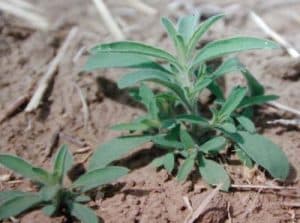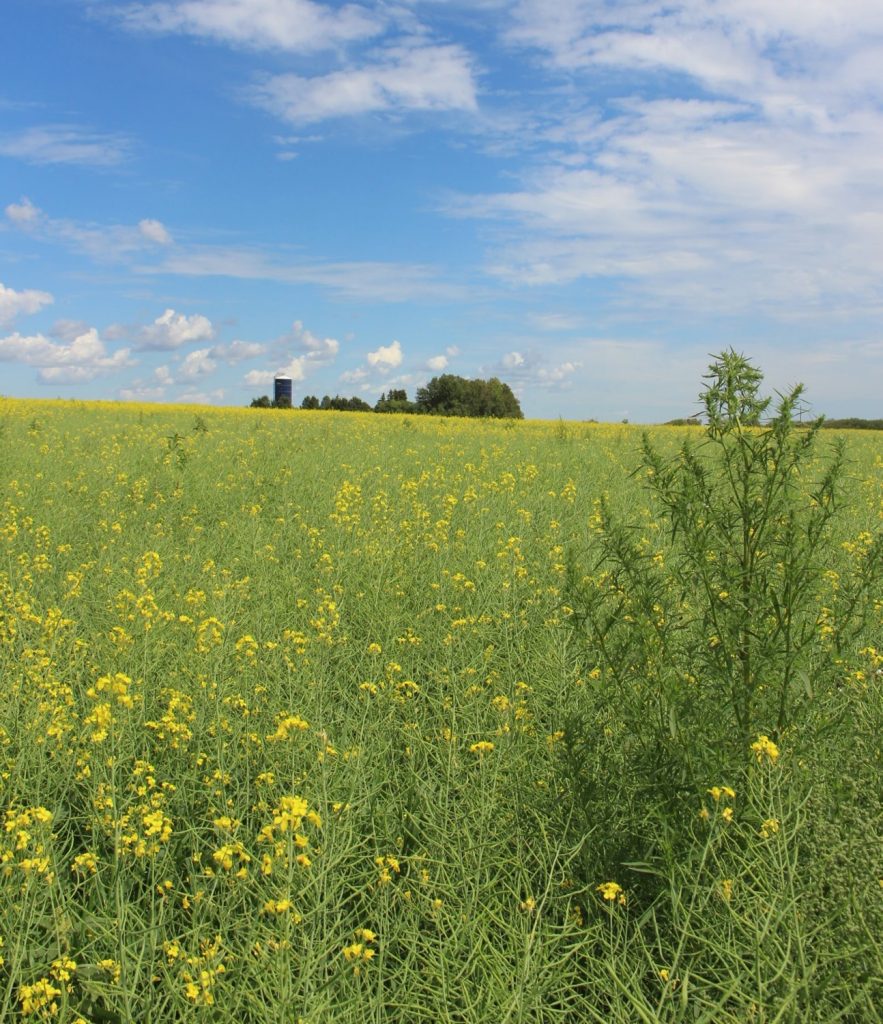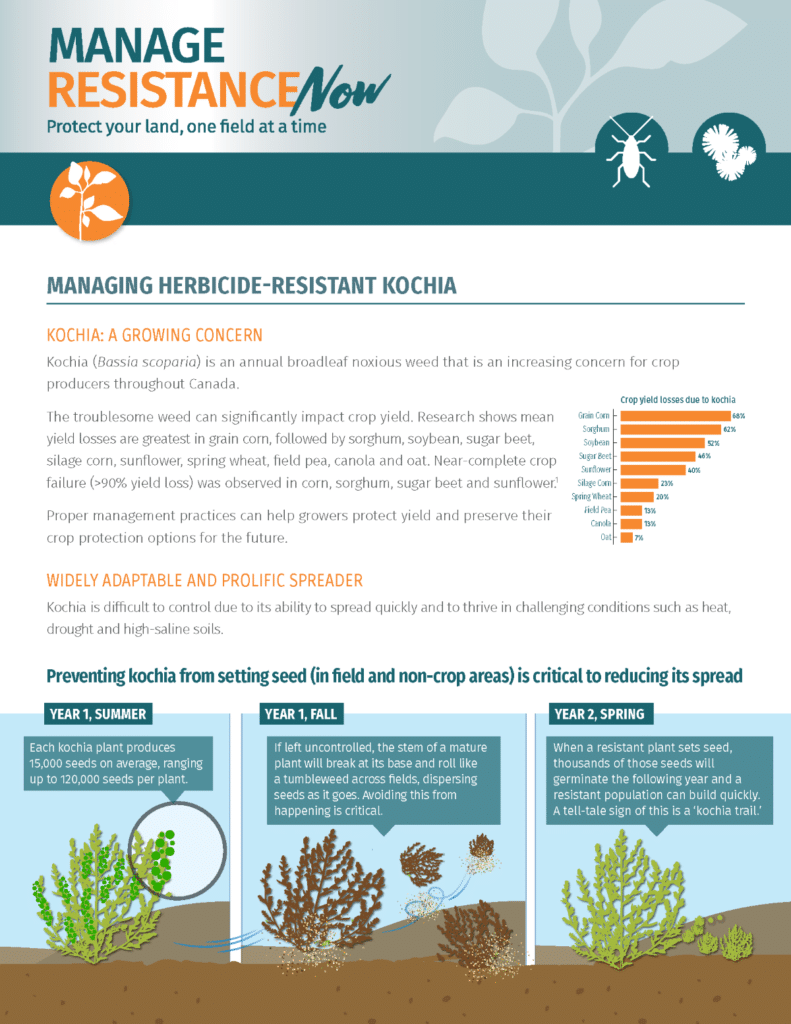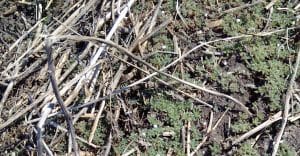Gardeners introduced kochia (Kochia scoparia) to North America as an ornamental in the 1800s. The large weed emerges early, grows rapidly and can tolerate salinity, drought and heat. Kochia often takes over saline or otherwise marginal areas where crops struggle to provide competition. When left to mature, kochia plants break off their stems and tumble with the wind, spreading seeds over a wide area.
Each kochia plant produces at least 15,000 seeds, often many more. Agriculture and Agri-Food Canada researchers (Robert Blackshaw et al) showed that kochia in dense patches with low crop competition can produce millions of seeds per square metre. Blackshaw also found that most kochia seeds will germinate or die within one to two years, so growers can quickly reduce the soil seedbank with management steps to prevent kochia from setting seed.
Resistance to multiple herbicide groups
Glyphosate-resistant kochia, confirmed in Southern Alberta in 2011, was the first glyphosate-resistant weed in Western Canada.

With kochia, glyphosate resistance builds on a sliding scale, increasing with subsequent non-lethal applications. For example, if kochia survives a 1X rate of glyphosate, offspring from that population may survive a 2X or 4X rate, and so on. (This applies only to glyphosate resistance.)
Agriculture and Agri-Food Canada surveys weed populations and the rise of resistance. The Alberta survey of 2021 found 78 per cent of kochia had some degree of glyphosate resistance. The Saskatchewan survey of 2019 found 87 per cent of kochia had glyphosate resistance. Manitoba was 58 per cent in 2018 in the same Glyphosate-or auxinic-resistant kochia and Russian thistle Prairie survey. Those numbers are likely to increase in the next round of surveys.
Agriculture and Agri-Food Canada researchers (Charles Geddes et al) confirmed a population of kochia in Saskatchewan in 2021 with resistance to Group-14 saflufenacil, and recently confirmed resistance to Group-14 carfentrazone and sulfentrazone. Group-4 resistance was confirmed in 2015, and almost all kochia is Group-2 resistant. Many kochia populations have stacked resistance to multiple groups. Kochia was always a hard weed to control. The job is much harder now.
Management
Use the following steps to contain kochia and keep patches from taking over large areas of a field:
Pre-seed burnoff
- apply early
- use an effective tank mix and
- scout later for escapes that could be resistant
Because kochia germinates early (80 per cent of kochia seedlings emerge before the crop), pre-seed burnoff can be an effective management strategy. However, because kochia germinates early, plants can be sufficiently large and survive standard herbicide rates without timely sprays. With pre-seed burnoff of kochia patches, use an effective tank mix.


Use an effective tank mix
With kochia showing resistance to herbicides in Groups 2, 4, 9 and 14, “effective” tank mixes have become more of a challenge. Definitely do not use glyphosate (Group 9) alone. Effective options ahead of canola include Group-6 bromoxynil and Group-27 topramezone. Group-14 options will be effective on most populations, and Agriculture and Agri-Food Canada research from 2013-15 showed excellent control of kochia in a pre-seed application. Agriculture and Agri-Food Canada is working to confirm whether Group-14 resistant populations are resistant to all Group-14 products, including carfentrazone and pyraflufen. For now, most kochia populations will still be susceptible to Group-14 products, but if using a mix of Groups 9 and 14 for a pre-seed burnoff, monitor closely. Escapes may have stacked resistance and should be removed before they set seed.
Use an effective in-crop spray
Group-10 glufosinate provided excellent control (>90 per cent) of kochia in the 2013-15 Agriculture and Agri-Food Canada study. (AAFC Blackshaw et al). This depends on weed staging, as best results depend on smaller (<15cm) kochia plants. In fields with kochia, plan to spray at the two-leaf stage of the crop. Genuity, TruFlex and Clearfield canola systems based on Group-9 and Group-2 weed control are no longer effective on most kochia across the Prairies.
Scout after spraying
If kochia plants survived pre-seed burnoff and the first in-crop spray, a second herbicide application (even a spot spray) may help if weeds and crop are still at appropriate stages for another application.
Mow or hand-weed kochia plants
If a second application is not possible or if kochia plants are too large, consider physical removal. Options include mowing areas where kochia is the dominant species and crop yield expectations are low. Hand weeding could be worthwhile in areas where individual resistant (or likely resistant) plants are present.
Test to make sure kochia is resistant (or just assume)
With herbicide-resistant kochia so common across the Prairies, it is safe to assume that kochia plants still growing after multiple sprays are resistant. Manitoba’s PSI Lab has a DNA test to check kochia leaf material for glyphosate resistance. PSI Lab testing services are available to anyone in Canada. All kochia is also likely Group 2-resistant. Commercial DNA tests are not currently available for Groups 4 or 14 resistance.
Set reasonable expectations for pre-harvest herbicide
There aren’t too many effective options for kochia after it reaches 15cm in height. In his field trials, Charles Geddes, weed research scientist with Agriculture and Agri-Food Canada, typically uses glyphosate plus saflufenacil to help dry down the kochia and allow them to straight combine. Reglone is another option. In either case, a preharvest timing won’t do much to help contain herbicide-resistant kochia patches. The purpose, Geddes says, is more to dry down the kochia to aid harvest and not plug the combine. A recent study found that a pre-harvest application of glyphosate plus saflufenacil decreased viable kochia seed production by 28 per cent, on average, when applied 10 days before harvest. That still leaves a lot of viable seed.
Use combine seed destroyers
A University of Saskatchewan study (Steve Shirtliffe et al) showed that kochia seed shed began at approximately 1,585 growing degree days, which coincided with the last week of September in 2015 and the second week of September in 2016. If the canola crop was harvested in mid-September, approximately 90 per cent of kochia seeds would remain on weed plants. If harvest was delayed to the end of September, approximately 56 per cent of kochia seeds produced would remain on the weed plants.
Because kochia is a prolific seed-producer, even 10 per cent of seeds can represent a few thousand seeds. However, combine weed seed destroyers can effectively destroy the other 90 per cent. (That same study also looked at pre-harvest diquat and glyphosate to manage kochia. These applications did not reduce the number of seeds shed by harvest time.) Recommendations from the study are to harvest as soon as the crop is mature and use chaff collectors or pulverization (seed destructor) equipment.
Apply Edge in the fall
One way to manage kochia patches is with Group-3 ethalfluralin (Edge) herbicide.
Edge applied in the fall or early spring (including on fields planned for canola) can help manage herbicide-resistant kochia. Proper fall timing is from October 1 up until ground is snow covered or frozen. If growers miss the fall window, early spring application can also work.
Apply the granular herbicide with a Valmar or spreader, and work it into the top 1/4” to 1/2” of soil. Ethalfluralin works through root and hypocotyl uptake prior to weeds emerging in the spring, so it needs to be in the soil. It can also be susceptible to losses from volatilization and/or light degradation if not incorporated properly. Without incorporation, efficacy can drop significantly. A light harrowing can be enough, ideally at a right angle to the planned seeding operation.
If conditions have cooled down in the fall, harrowing in the spring after a fall application can also work. Two things to note here: Edge granules applied in fall need to reach the soil surface to bind with soil particles, even if incorporation happens in spring. Incorporation should happen before seeding canola. In many cases, the seeding tool does not provide complete incorporation across the soil surface.
Edge applications can be targeted to kochia patches rather than the whole field. Apply the herbicide somewhat beyond the patch because harrow or cultivar incorporation can spread kochia “carcasses” and their seeds beyond the patch area.
Implement long-term management strategies
Controlling herbicide-resistant kochia often requires a long-term, multi-pronged approach. Options:
- Seed kochia-infested areas to salt-tolerant perennial forage rather than continue to throw inputs at acres with no hope of profitability.
- Diversify the crop rotation with early- and late-seeded crops, including winter cereals and forages to provide early-season competition with kochia seedlings.
- If poor drainage is at the root of salinity problems, localized tile drainage may remediate low productivity areas where kochia tends to thrive.
More
- Integrated weed management: Best practices
- Managing herbicide-resistant kochia (from Manage Resistance Now)
- The Prairie Weed Monitoring Network
- The latest (2023) report on Prairie-wide survey results includes maps showing the spread of Group-9 resistant kochia
- Canola Research Hub blog on herbicide-resistant weed management
- Canola Watch podcast on herbicide-resistant weeds with AAFC research scientists Charles Geddes and Shaun Sharpe
- Suspicious weed patches? Check for resistance
- Watch for suspicious weed patches

